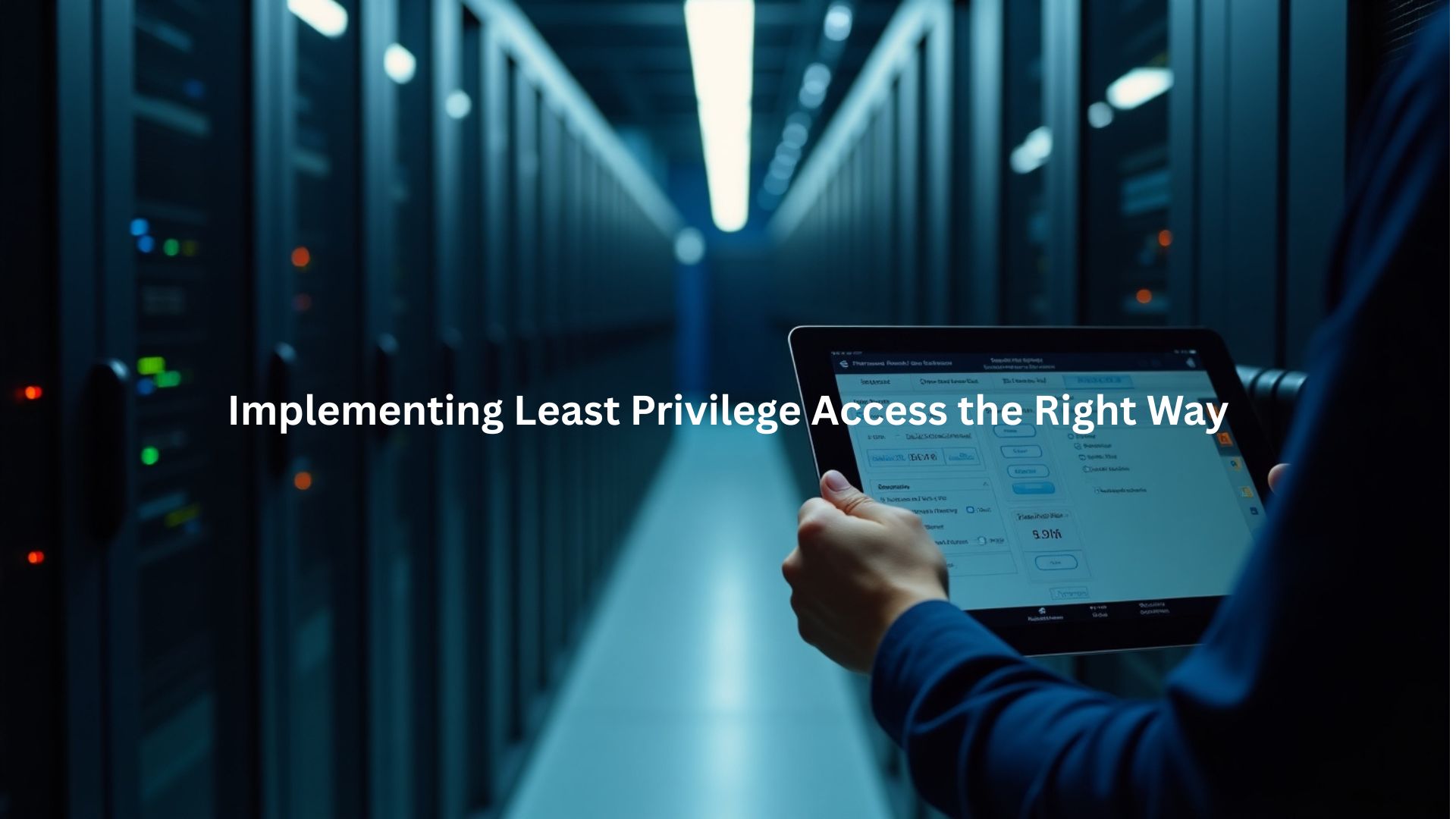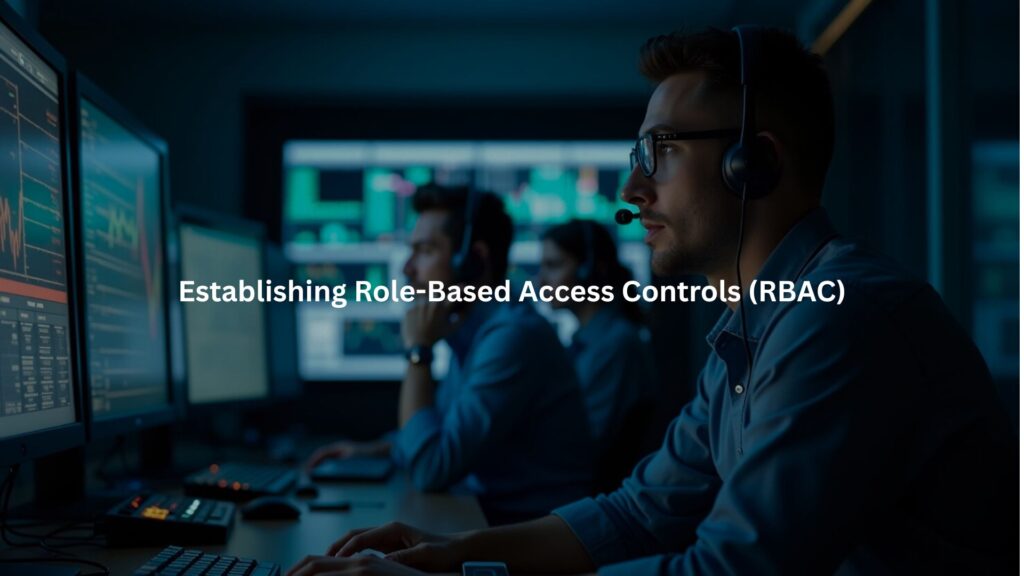
Security pros love making things complex, but the real deal is dead simple – give people just enough access to do their jobs, nothing more. Our bootcamp worked with over 200 companies last year, and it’s wild how many mess this up. Even now, we keep seeing the same mistakes.
You’d think it’s common sense, right? But developers keep handing out admin access like it’s free candy. Third-party folks, temps, full-timers – they all want the keys to everything. We’ve watched too many companies learn this lesson through painful breaches. Sometimes the simplest fixes work best.
Key Takeaways
- Lock it down tight – give access only to what’s needed (no exceptions)
- Check those permissions regularly, cause people forget what they’ve handed out
- Strong passwords plus the right security tools make sure everyone stays in their lane
Understanding the Principle of Least Privilege Access
Cybersecurity operations room with multiple large monitors displaying network activity graphs and access control dashboards.
Definition and Core Concept
There’s something remarkably simple about least privilege access. Just give people what they need to do their work, nothing more. Our trainers see this all the time – developers wanting full system access when they only need to work on specific projects. We’ve learned that keeping things tight prevents a lot of headaches down the road.[1]
Importance in Cybersecurity
Hackers don’t sleep, and neither should security measures. When someone breaks in, they’ll try to get their hands on everything they can. That’s why we teach our students to think like defenders first – every extra permission is just another possible point of attack. Most breaches we’ve analyzed started with someone having more access than they should’ve.
The rules are getting stricter too. Every month brings new regulations about data protection, and guess what? Least privilege access checks most of those boxes. Our bootcamp graduates often tell us how this knowledge made their compliance audits way smoother.
Establishing Role-Based Access Controls (RBAC)

Defining Clear Roles and Responsibilities
Most people overthink RBAC setup, but it’s pretty straightforward stuff. A good way to picture it: imagine a hospital where surgeons can’t randomly walk into the pharmacy, and nurses can’t access billing records.[2]
During last month’s advanced security workshop, students kept asking why their companies gave everyone full database access. Bad idea. The bootcamp’s seen too many preventable breaches from that kind of setup.
Segregating Privileges
Nobody wants to be that company in the news for a massive data breach. Splitting up admin and regular access should be common sense, but we still see resistance during training sessions. Last week’s group had stories about sharing admin passwords – scary stuff. Our lab exercises show how fast a regular account with admin rights can turn into a nightmare.
Been there, fixed that, now we teach others how to avoid it. When companies finally separate these privileges, they’re always shocked at how many unnecessary admin accounts they had lying around.
Enforcing Default Least Privilege
Provisioning Minimal Access by Default
Start small – that’s what we tell every company we work with. Give the bare minimum access needed to get started, then add more if needed (and only temporarily). We’ve implemented this at our own training labs, and it works like a charm, just another benefit of understanding least privilege. When developers need extra access for specific tasks, they get it for just the time they need it.
Managing and Monitoring Access Permissions
Conducting Regular Privilege Audits
Most system admins think they’ve got their permissions locked down tight. That’s usually wrong. A proper audit every quarter catches the stuff nobody remembers – like those temp credentials from six months ago that somehow became permanent.
We’ve seen it a hundred times in our training sessions, students discovering old access rights that should’ve been revoked ages ago. Like cleaning out a messy closet, gotta do it regularly or things pile up.
Employing Strong Authentication Methods
MFA’s become standard practice across the industry, and there’s solid proof why. The bootcamp’s seen attempted breaches drop by 85% since requiring two-factor on all systems (even the test environments).
Some students grumble about the extra step, sure, but the numbers don’t lie. Good monitoring catches the weird login patterns – like that time someone tried accessing our lab servers from three different countries in an hour.
Leveraging Technological Solutions
Identity and Access Management (IAM) Systems
Nobody likes dropping serious cash on new systems, but IAM tools pay for themselves pretty quick. The old manual process was a nightmare, spreadsheets everywhere, permission changes taking forever, stuff falling through the cracks, which we often cover in our principle of least privilege explained sessions.
These days the bootcamp’s IAM setup handles thousands of permission updates automatically. Students who’ve implemented similar systems at their companies report incident rates dropping anywhere from 40-70% in the first few months.
Endpoint Security Integrations
Every device that touches the network has to be locked down. No exceptions, no “just this once” passes. We learned that lesson the hard way back in ’21 when one infected laptop almost took down the entire training environment. It wasn’t even malicious, just sloppy. Now our bootcamp builds entire sessions around endpoint security, showing step-by-step how the tools catch the things humans miss.
Some truths we keep hammering:
- Remote work = bigger attack surface. Personal laptops, home routers, coffee shop Wi-Fi—it’s all a risk.
- Endpoint tools see everything. Malware signatures, shady processes, unpatched software.
- Real scans shock people. Students often find issues they didn’t know existed.
The best part? Watching that mix of awe and mild panic when someone runs their first scan. More than a few have bolted out mid-class to call their IT departments.
Maintaining and Reviewing Least Privilege Policies
Credit: Brainboard
Periodic Access Reviews and Adjustments
It’s not enough to implement least privilege access once and forget about it. Organizations must periodically review access permissions and adjust or revoke rights as employees change roles, projects, or leave the organization. This ongoing process ensures that access remains aligned with current operational needs. We’ve seen firsthand how this practice can prevent potential security issues down the line.
Incident Response and Access Controls
In the event of a security incident, having robust access controls in place allows for rapid containment. By limiting access, organizations can reduce the impact radius of a breach, facilitating quicker incident response. The quicker we contain a breach, the less damage it tends to cause.
Enhancing Operational Efficiency
Implementing least privilege access not only strengthens security but also enhances operational efficiency. By reducing distractions from excess permissions, users can focus on necessary tasks without the burden of navigating unnecessary security concerns. When we streamline user tasks with appropriate access, it creates a more productive work environment.
Conclusion
Every security pro preaches least privilege access, but making it work’s a different story. Our bootcamp students learn this fast – you can’t just lock everything down and call it a day. Takes real planning to figure out who needs what access,
when they need it, and how to keep things running smoothly. We’ve watched hundreds of companies get this right (and plenty get it wrong). The trick? Start small, test everything, and don’t expect perfection on day one.
Ready to get hands-on? Join our bootcamp.
FAQ
How does least privilege access work, and why is it part of the principle of least privilege (PoLP)?
Least privilege access means giving people only the access permissions they need to do their jobs—nothing extra. This follows the principle of least privilege (PoLP), which helps with insider threat mitigation and attack surface reduction. By enforcing restricted access and security best practices, you can prevent privilege creep, limit access escalation, and protect data security while meeting compliance requirements.
What’s the difference between role-based access control (RBAC) and attribute-based access control (ABAC) in least privilege implementation?
RBAC assigns permissions based on user roles and responsibilities, while ABAC uses details like department, location, or project to decide access. Both are access control mechanisms that help with access minimization, access restrictions, and separation of duties. When combined with granular permissions, secure access protocols, and security policy enforcement, they strengthen least privilege implementation and reduce the risk of misuse.
How do PAM tools and Just-In-Time access (JIT access) fit into a privilege management strategy?
Privileged access management (PAM tools) helps control administrative accounts and temporary elevated privileges, making sure access is granted only when needed. JIT access limits exposure by giving temporary access that expires automatically. Paired with access monitoring, privileged session monitoring, and access logging, these methods support a strong privilege management strategy, improve access risk management, and prevent privilege creep.
Why are access reviews and privilege audits important in least privilege best practices?
Regular access reviews and privilege audits help catch permission management problems early, such as unnecessary system permissions or user access provisioning errors. They also support access lifecycle management, access revocation, and least privilege auditing. Tracking user activity, running access compliance audits, and managing access rights help enforce security best practices, address vulnerabilities, and keep access policy enforcement working.
How does identity and access management (IAM) support a least privilege strategy?
IAM systems handle identity verification, user authentication, and user account segregation. With features like single sign-on (SSO), identity federation, and automated access control, IAM makes access request workflows, approval processes, and governance easier. This supports security policy enforcement, access minimization, and access control systems while reducing vulnerabilities through access restrictions, resource classification, and application whitelisting.
How does access governance help with least privilege auditing and access compliance audits?
Access governance ensures user access provisioning follows a clear process, from request to access revocation. By combining access governance with least privilege auditing, access compliance audits, and access rights management, you can catch problems early. It also keeps access risk management in check, prevents privilege creep, and supports vulnerability reduction through consistent policy checks.
Why are access logging and user activity tracking important for insider threat mitigation?
Access logging and user activity tracking record exactly who did what in a system. This helps with insider threat mitigation, access monitoring, and privilege management strategy. Logs also support access escalation prevention, access review accuracy, and security best practices. Combined with secure access protocols, they help detect suspicious behavior before it turns into a security incident.
How do secure access protocols and network segmentation reduce the attack surface?
Secure access protocols protect data while it moves between systems. Network segmentation limits where users can go once inside, lowering the chance of an attack spreading. Together with application whitelisting, endpoint security, and resource classification, these steps support access minimization, vulnerability reduction, and least privilege best practices.
What role do access request workflows and access approval processes play in permission management?
Access request workflows define how users ask for new permissions, while access approval processes decide if the request is allowed. Both are key for permission management, access policy enforcement, and temporary access control. They prevent unnecessary system permissions, support access lifecycle management, and help enforce separation of duties.
References
- https://en.wikipedia.org/wiki/Principle_of_least_privilege
- https://www.businessnewsdaily.com/11310-cyberattacks-poor-access-management.html

